Each generation has its own deviation. Rearmament of the Russian Navy
Gifts accept.
Everything in life will be fine
My friend, do not forget!
The central design bureau of marine equipment (TsKB MT) Rubin decided to celebrate the Day of the submariner (March 19 is traditionally celebrated) with knowledge of the matter - a statement about the beginning of work on the creation of fifth-generation boats caused good emotions for everyone who cares about the Russian navy . Progress and progress are always for the better. But some seafarers reasonably noticed that before stepping foot on the newly painted deck of the fifth generation nuclear-powered icebreaker, he would like to walk a little on the seas on fourth-generation submarines.
The problem is that the Russian Navy has only one fourth-generation submarine - the well-known K-535 “Yuri Dolgoruky”, the lead strategic submarine of the 955 project (the Borey cipher).
K-535 was officially included in the lists of ships of the North fleet just 2 months ago - January 10, 2013. At the moment, the nuclear-powered test is being tested, the crew is preparing to enter the first combat patrol, which, according to the plan, is due to take place in 2014.
At first glance, having such a deep and rich "groundwork" for fourth-generation submarines, it is simply blasphemous to make any promises about the next generation of equipment. However, first things first ...
History nuclear submarine fleet taken into four eraseach of which reflects crucial changes in the views of military theories on the use and effectiveness of armaments, the results of the achievements of scientific and technological progress and the emergence of new technologies - and, as a result, a radical increase in the combat capabilities of nuclear-powered ships.
The submarines of the first generation, in spite of the absolutely fantastic capabilities in comparison with the diesel engines, were in many ways experimental equipment — extremely inconvenient and dangerous to operate, with ships of imperfect design and armament. The legendary Nautilus, the Soviet firstborn of K-3 Leninsky Komsomol, the ominous K-19 - these are the representatives of the first generation of atomarin.
The accumulation of operating experience of nuclear power plants, significant scientific and industrial progress in shipbuilding, electronics, precision engineering - all this, ultimately, led to the emergence of the next, second-generation submarines. The working speeds and depths increased markedly, the submarines received new hydroacoustic complexes, which radically increased the possibilities for controlling the surrounding space.
The third generation of nuclear submarines was distinguished by increased standardization and unification of systems: Soviet industry developed a unified power plant for all future submarine projects based on the OK-650 reactor, and the Americans finally switched to high-volume construction in just two projects: a strategic and multi-purpose submarine. The atomicars have significantly increased in size, the underwater displacement of the legendary “Shark” - the strategic rocket carrier of the 941 project has reached 50 000 tons!
“K-141“ Kursk ”aircraft carrier killer, strategic submarine cruisers of the 667BDRM project, American“ Los Angeles ”and“ Ohio ”, British“ Trafalgar ”and“ Vanguard ”- third-generation submarines still form the basis of the submarine fleet of all developed countries of the world.
It is worth noting that due to the difference in views on the use of the navy, as well as due to the national characteristics of the military-industrial complex and an extraordinary “spread” in time, the submarines of the same “generation” differ greatly from each other. Sometimes it is difficult to determine if atarins belong to a particular “generation”; each project has its own individual characteristics, important advantages and disadvantages.
For example, Americans have achieved phenomenal successes in the field of safety of nuclear power plants. Reactor safety is the business card of the US Navy. A submarine armed with cruise missiles — a specific class of submarines that had virtually no analogues abroad — became the hallmark of the Soviet submarine fleet. Another example: no one in the world managed to create something similar to the Soviet “long torpedo” - a super-ammunition caliber 650 mm with a range of 100 km. The speed in attack mode — 70 units (≈130 km / h) —the third generation of Soviet nuclear submarines carried 8-12 of such “gifts”, half of which were equipped with SBCh. Released by a fan on homing from a safe distance, they were able to stop any aircraft grouping. The odd rocket-torpedo “Squall” is just a puppy compared to the power of a “long torpedo” (index 65-76). The mere presence on board of such weapons brought the domestic submarine fleet to a new level.
Which generation is the last atomic submarine of the twentieth century - the incredible ship "Sivulf" (sea wolf)? Created at the turn of the third and fourth generations, the Sivulf objectively surpasses any of the existing fourth-generation submarines, and in a number of parameters it meets the requirements for the fifth generation of nuclear submarines.
It is obvious that the dispute about the "generations" of submarines cannot be conducted in abstract formulations: "noise reduction", "automation of control systems", and "increased reactor safety". The combat capabilities of the boats are fully determined by specific facts related to their design features and tactics of their use.
So, the fourth generation of submarines. Only facts and key features.
"Sivulf", the first submarine of the fourth generation:
- high “tactical” speed - it’s not a secret that the submerged speed of a modern boat is determined not so much by the power of the power plant and the hull lines as by its hydroacoustic means: at high speed, the noise of incoming water makes it impossible for the boat to orient in space. With the help of thousands of hydrophones, sonars and sensors gathering information about the surrounding space, the creators of the Sivulf managed to achieve a more or less acceptable quality of the information received up to the speed of 25 nodes (for comparison: conventional third generation boats hopelessly “stall” when overclocked over 20 nodes).
- “Sivulf” is a real underwater killer, armed with a weapon with a “silencer”: its torpedo engines are launched directly in torpedo tubes and torpedoes leave the hull of the boat independently - unlike all other submarines that use compressed air blowing (very loud, unmasking sound, definitely convincing enemy acoustics in the intentions of the submarine).
- a magnificent set of working depths and speeds: maximum submerged travel - 35 nodes, maximum depth of immersion - 600 meters.
- active noise suppressors, “fancy” weapons, huge ammunition (up to 50 torpedoes, mines and cruise missiles) - “Sivulf” was created specifically for underwater hunting for promising Soviet boats. Alas, promising Soviet submarines did not appear, and no one needed “a superheroe” for 3 billion. The Americans mastered the construction of only three ships of this type (built in the period from 1989 to 2005), the remaining "white elephants" of the US Navy.
The next vivid example is four Ohio-type submarines (head, second, third and fourth hull). Four strategic submarine missile carriers were beyond the scope of the strategic offensive arms reduction treaty and were to be disposed of. However, instead of recycling, the US Navy leadership chose to upgrade and convert the extra Ohio into tactical cruise missile carriers. Formally, not being the fourth generation boat, but having Tomahawk on board the 154 - the Ohio's destructive power goes far beyond the requirements of the fourth generation submarines. Tomahawks, two airlock chambers for combat swimmers (instead of 23 and 24 missile shafts), reduced noise and a set of torpedo weapons - converted Ohio perfectly meet modern conditions: a multifunctional, invulnerable means for waging local wars. What generation are these submarines?
When the story of the Sivulf project ended, the story began project "Virginia" - at first glance, a multi-purpose submarine of the type "Virginia" looks dimly against the background of the legendary "sea wolf". But the first impression is deceptive - the "Virginia" is a completely different boat, created for very different tasks. Hence the enormous difference in performance. To date, nine submarines of this type are in service, five more are in varying degrees of readiness. In total, the plans of Americans to build up to Virginia 30.
The US Navy is uniquely positioning its "Virginia" as the fourth generation of boats, to which they have a number of arguments:
- for the first time in world practice, a “disposable” nuclear reactor S9G was used on the submarine, which does not require recharging during the entire 30-year life cycle of the submarine - from construction to disposal;
- modular design, a system of insulated decks and combat modules, all equipment inside the boat is standardized for blocks of 19 and 24 inches wide - to facilitate the repair and modernization of the ship;
- multifunctional telescopic mast with video cameras, thermal imager and laser range finder. Everything that happens on the surface is transmitted to the monitors in the central post;
- Unmanned automatic devices for detecting mines and performing special tasks in the water column;
- a multifunctional weapon complex: torpedo tubes, 12 vertical mines for launching cruise missiles, a lock chamber for 9 combat swimmers, as well as a reduced level of internal noise make the boat a deadly enemy. One of the priorities of "Virginia" is to carry out operations in the coastal zone: covert surveillance, radio reconnaissance, landing of sabotage groups, shelling of coastal targets with cruise missiles, search and rescue missions.
If Virginia was built in Russia, it would be immediately recorded in the sixth-generation boats. And this is not a joke - domestic nuclear-powered project 955 (Borey), equated to the "fourth generation" has none of the above devices. Undoubtedly, Borey is significantly different from all its predecessors - thanks to the modest dimensions of the R-30 SLBM Bulava, they managed to get rid of the hump on the body of the submarine; for the first time, a water jet propeller was used on domestic submarines; Amphora-B-055 ”, combining all the hydroacoustic equipment of the boat. According to representatives of the TsKB MT Rubin, the Boreya hydroacoustics surpasses the hydroacoustic means of the American Virginia submarine, the recognized leader in this field.
In words, it’s great. However, one should not forget that the Borei were built twice - with their construction, ready-made sections from the unfinished third-generation submarines of the 971 Shchuka-B projects and aircraft carrier killers of the 949A project are used. In a certain sense, the submarine of the Borey project does not exist - these are slightly different in design nuclear ships carrying submarine-based missiles from 16 to 20 (and initially, the boats were calculated on BNK 12 missiles).
Of course, this does not mean that the Borey is a copy of third-generation submarines. But given the identical design of the majority of the case, it is clearly not worth waiting for any radical changes compared to the 971 and 949А projects. Another example: on the fourth-generation domestic submarines, GEMs based on the OK-650 reactor are used, almost completely unified with GEMs of the third-generation submarines — no changes have occurred in this critical area either.
K-535 "Yuri Dolgoruky" - a boat in every sense necessary, strategic-class submarine cruisers are one of the main components of the "nuclear triad". A modern SSBN is a specific weapon. The only task is to periodically go on combat patrols and, after due time, return to their home base. Without any accidents and technical problems. More from it is not required. The emergence of submarine-launched ballistic missiles with a range of 10 thousands of kilometers allowed modern SSBNs not to even leave their territorial waters and patrol where the presence of a “likely enemy” is minimized - the Arctic, the polar seas ... if necessary, the boat can shoot straight from pier in Gadzhiyevo.
The relatively simple and cheap "Borey" with updated internal systems and a proven OK-650 reactor is the best fit for this concept.
Much more interesting is the situation with other representatives of the domestic submarine fleet - multipurpose nuclear submarines with cruise missiles of the 885 project (code "Ash"). The newest type of Russian submarines, no doubt, fits the criteria of the fourth generation. He is able to replace the multipurpose submarine "Pike-B", and the "aircraft carrier killers" project 959A "Antey".
- by analogy with the American boats, a giant spherical antenna of the hydroacoustic complex, occupying the entire nose of the boat, was installed on the Yasen,
- 10 torpedo tubes located in the middle of the boat, perpendicular to the longitudinal axis;
- 8 missile silos CM-346, with 32 ammunition cruise missiles of the Caliber complex or P-800 Onyx;
- electric motor for slow travel (sneaking mode);
- overview tele-system MTK-115-2 (allows optical monitoring at depths up to 50 m);
- on the Yasen, as well as the Virginia-type submarines, instead of the traditional periscope, there are non-penetrating masts with video cameras, the data from which are fed to the monitors of the central post via fiber-optic cable.
However, directly comparing the "Ash" with the "Virginia" would be incorrect: these boats are designed to solve various problems. The Russian submarine is much larger, with the main emphasis on actions in the open ocean. A powerful, multifunctional ship will be one of the best boats in its class.
The only snag is that not a single "Ash" has yet been enjoyed by the Russian Navy. This is despite the fact that the head boat of the project - K-329 "Severodvinsk" was built from the 1993 of the year, and from the 2011 of the year went into sea trials. Alas, the signing of the acceptance certificate is delayed - too complex construction requires a lot of time and effort to fine-tune all systems of the underwater ship.
Conclusion
As for the loud "pre-holiday" statement of the TsDB MT "Rubin" about the beginning of the creation of fifth-generation submarines, the journalists somewhat distorted the information - the statement said about the beginning of work on shaping the appearance of the fifth-generation submarines, whose construction will begin no earlier than 2030 of the year. It is not yet clear what the ships will be and what their tasks will be. Nevertheless, the Russian shipbuilders have already thought about this topic and, in the future, are ready to create new submarines. Absolutely correct position with an eye to the future.
But, news Too much importance is attached to the beginning of the creation of fifth-generation submarines - it is much more important that shipbuilders do not “hover in the clouds” about plans for the 2030 year, and quickly transfer the practically ready-made submarine K-329 to Severodvinsk to the fleet and build its analog Kazan on the modernized project 08851 "Ash-M". Otherwise, it is useless to talk about the fifth generation.
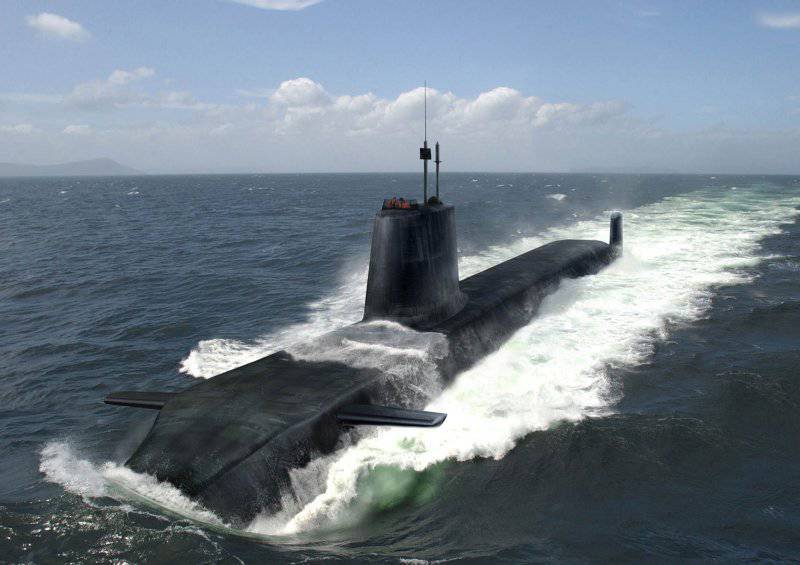
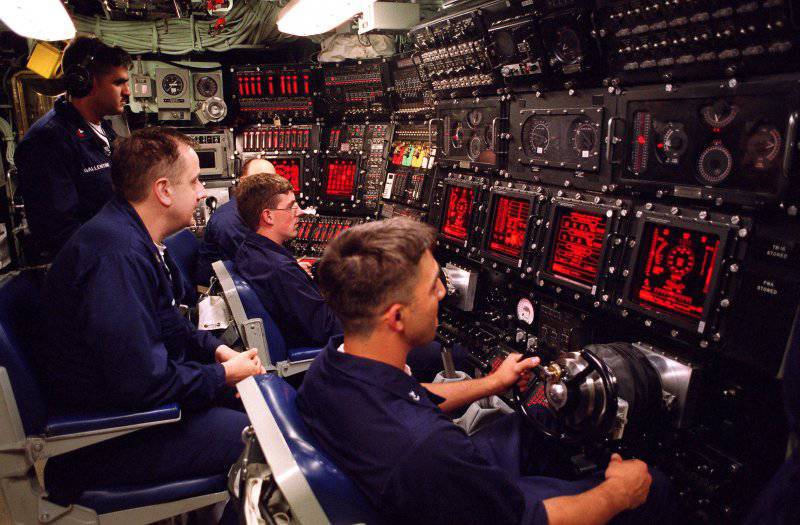
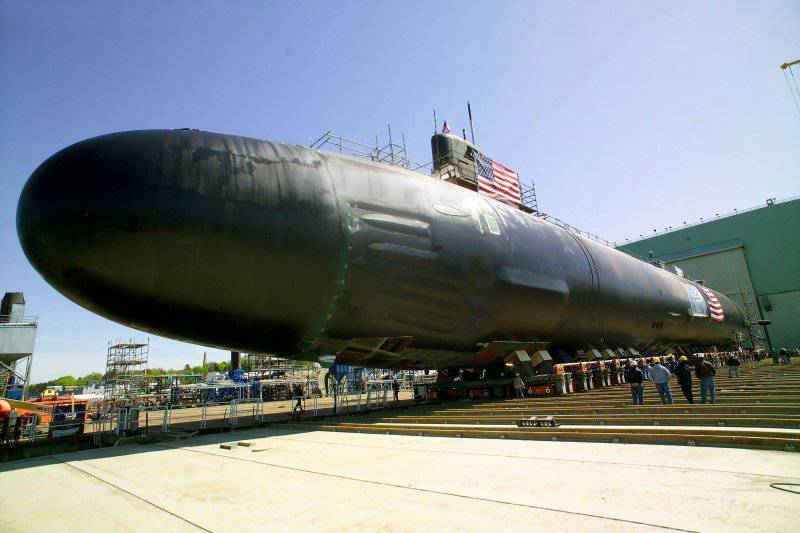

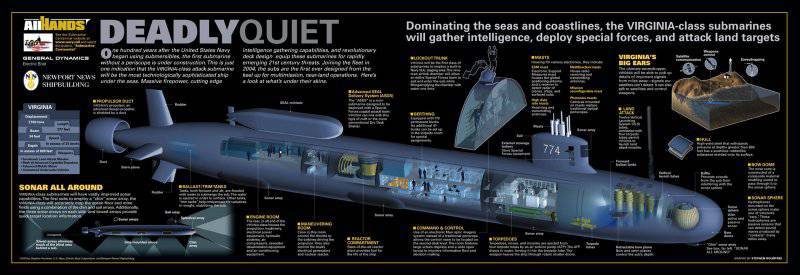
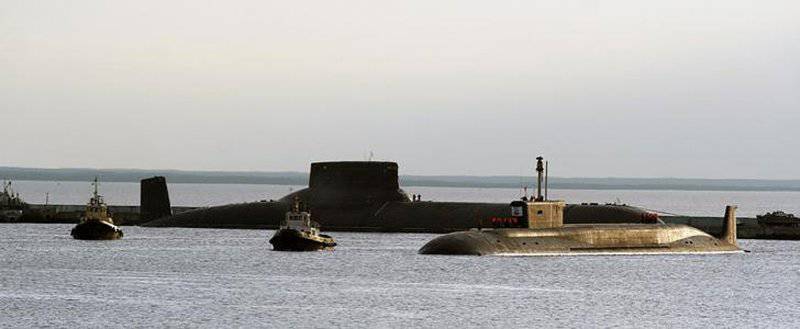
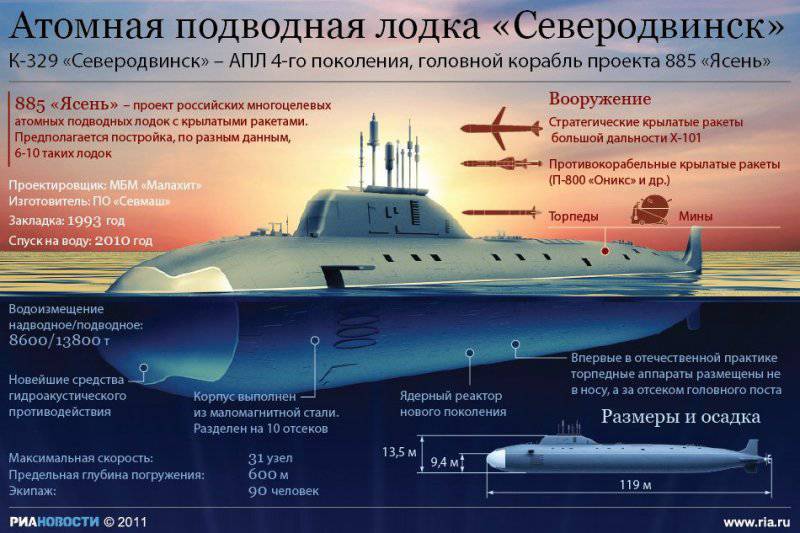
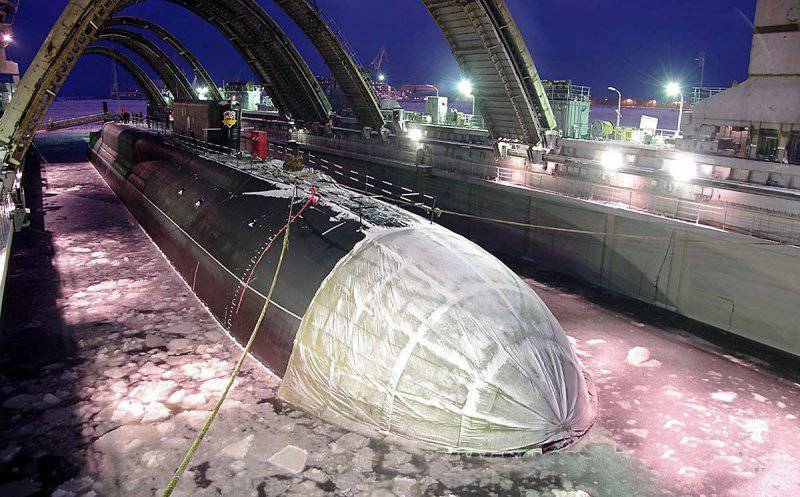
Information